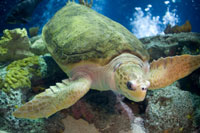New report shows loggerhead sea turtle numbers are declining.
After encouraging gains in the 1990s, a federal report now shows populations of loggerhead sea turtles dropping, possibly as a result of commercial fishing, according to a NY Times article.
The report, a five-year status update required under the Endangered Species Act, did not change the turtles’ status to endangered from threatened, but scientists and environmentalists said it was a cause for concern.
The Southeast, particularly Florida, is one of the two largest loggerhead nesting areas in the world — with eggs laid and hatched along beaches from Texas to North Carolina. Oman is the other major nesting area.
The report showed nestings in the United States dropping about 7 percent a year on the Gulf of Mexico. In southern Florida, nestings were down about 4 percent a year, and populations in the Carolinas and Georgia have dropped about 2 percent a year.
The decline among the loggerheads was a turnaround from the 1990s. In South Florida, nesting studies had shown gains of about 4 percent per year from 1989 to 1998.
Researchers were puzzled by the change, but some said it might be a result of expanded commercial fishing operations. The federal report called fisheries the “most significant man-made factor affecting the conservation and recovery of the loggerhead.”
The loggerhead, believed to be one of the world’s oldest species, can grow to more than 300 pounds and lives most of its life in the sea, migrating vast distances.
The report was compiled from various sources by the Fish and Wildlife Service and the National Marine Fisheries Service, which jointly have jurisdiction over protecting the turtles. The agencies also issued updates on five other sea turtles from around the world, with mixed results.
To read the full article, click here.



